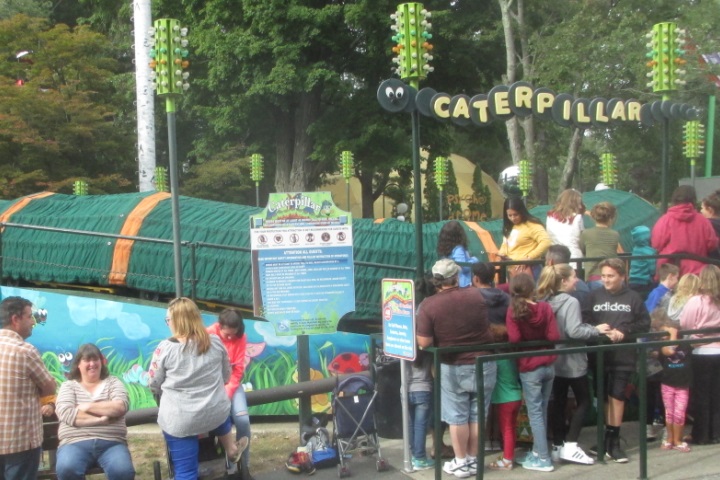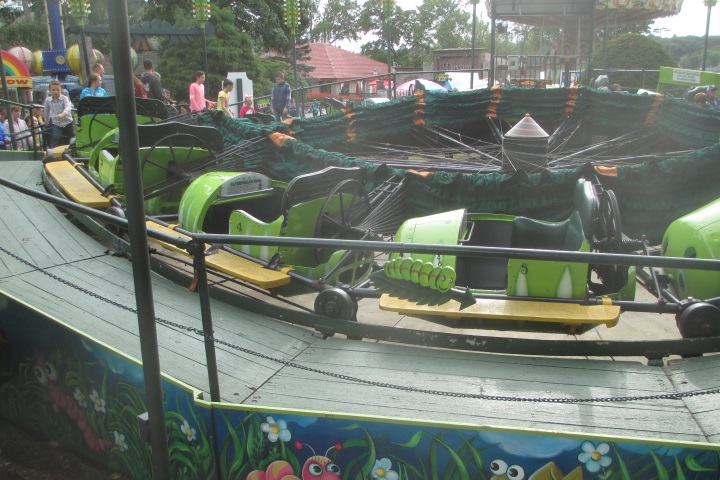
The Caterpillar
If you have seen one of these rides, you probably approached it while it was running. You saw what suggested a gigantic worm or caterpillar, big enough to hold (have eaten) people, chasing its tail around in a circle. Then as you walked up the ramp to the boarding area, the canopy top lifted up and over, starting from the outside, revealing the riders, seated mostly two by two, in little ride cars joined front to back and going around in a circle, all gliding to a stop.

When it was your turn to ride, you found an empty car and sat down on the bench. As positioned, the bench had the cloth canopy crumpled up on your right and with the boarding platform on your left. When the ride got up to speed the edge of the canopy was drawn up and over, enclosing you in what you might think of as a dark tunnel (or the belly of a giant caterpillar). If it was daytime there was still enough light for you to see part of the chain of cars up ahead wiggling up and down to follow the undulating track.
Different rides have been named "Caterpillar." We are referring to one that was introduced ca. 1920 and commonly found in amusement parks in the 1925 to 1960 time frame. Only a few of those rides are still in operation. This description is based on the writer's recollection of decades past together with 2017 observation and inspection of a Caterpillar ride at Canobie Lake Park in Salem, NH. According to Wikipedia, the ride was developed by a Mr. Hyla Maynes and most were manufactured by Traver Engineering (Harry Traver, founder).
The main ride framework has a series of (in this example, eighteen) gigantic spokes extending from a central hub out to the single rail circular track along the edge of the boarding platform. The (eighteen) cars each have a single bench for two adults and are suspended between adjacent spokes. The cars are not specifically banked inward. In fact when a car reaches a valley in the undulating track, the bench seat is banked slightly outward, accentuating the effects of centrifugal force that causes the rider sitting on the inside to be pushed against the rider on the outside. Thus a sign posted at the ride suggests that children or lighter persons sit to the right of heavier persons.
In typical operation the canopy is deployed when the ride gets up to speed and re-opened near the end of the ride cycle. Most rides at Canobie Lake Park today use a single button press which starts the ride, goes through the ride motion sequence (including deploying the canopy for the Caterpillar) and delivers a uniform ride experience and length each time. Decades ago, the Caterpillar had separate manual controls with low, medium, and high power settings needed to achieve a smooth acceleration, and controls to deploy and furl the canopy.
Technical Notes
The entire ride assembly, spokes arms and cars, form a gigantic (horizontal) pulley around the perimeter of which a driving cable is wrapped. In this example the driving cable leaves the rotating ride assembly and goes under the operator's podium where the motor and (smaller, perhaps 4 foot) driving pulleys are located, and then returns to the ride assembly. Years ago the (stationary) motor sat on the ground under the path of the cars and made loud screeching noises heard by the riders as their respective cars passed over it. For this older motor arrangement, the most likely mechanism was a friction rim drive with with a rubber wheel (automobile tire) contacting smooth running boards that ran all the way around the underside of the perimeter of the ride car and spoke assembly. This writer does not recall feeling a "bump" that such a drive wheel might impart each time his car passed over such a rubber wheel. Both of these driving methods are quite common for amusement rides today.
From an internet video we observed the Canobie Lake caterpillar ride operating at a top speed of about nine revolutions per minute.

The canopy is deployed (closed) and furled (opened) by an array of cables, one per car, that run from the hub of the ride out to the ride cars and back to the hub. At the back of each ride car is an approximately two and a half foot wheel, actually a pulley around which the control cable runs, that controls the canopy. The topmost (as shown) radial arm, or strut, is attached to this pulley and pulled like a windshield wiper to lift the edge of the canopy up and over the cars and riders. Additional struts attached only to the pulley axle and to spots on the canopy are pulled up and around passively to hold the canopy in its half cylindrical shape when the canopy is deployed. When the lower cable end is pulled the canopy is deployed and when the upper cable end is pulled the canopy is furled. All of the cable ends are attached to an upright cylindrical drum at the hub of the ride.
Major parts with quantity in parentheses:
A -- Upper control cable end (18), used to furl/stow the canopy.
B -- Lower control cable end (18), used to deploy the canopy.
C -- Spoke arm (18) of main frame and car "rotor" assembly.
D -- Truss rod to keep the spoke from sagging (18) .
E -- Slack adjustment for each cable end (36) .
F -- Stationary radial rods (18+), to keep the ride hub centered.
G -- Leg (4) of tripod-like assembly to keep hub axle vertical.
H -- Conduit (1) for remote control of hub mechanisms.
Most of the time the center drum freewheels in step with the rest of the ride assembly at which times the canopy holds its position. In the actual operation, shortly after the ride reaches full speed, the center drum is stopped, perhaps by being jammed by a stationary spline driven up into it. The rest of the ride assembly continues to rotate causing the lower cable ends to wrap around the drum like ribbons around a May pole (without interweaving) and in turn tug on the respective canopy mechanisms at the back of each car.

It takes about a half revolution of additional drum rotation to deploy or to furl the canopy. There must be some mechanism, we are not sure what it is, to unjam the center drum and allow it to resume rotation in step with the rest of the ride. Another mechanism we are currently unsure of must rotate the drum the other way, faster than the rotation rate of the rest of the ride from a point of view on the ground, to pull the upper cables and furl the canopy. We observed that furling of the canopy occurred as the end of the ride cycle. So the drum at the hub only needed to be forcibly cranked at about the normal ride rotational speed as the rest of the ride coasted to a stop. We judged that the center hub and drum were not robust enough to have ever used a hub drive, that is, the motive power for the entire ride applied to the hub.
It appears that it requires about fifty pounds of pull on a cable to operate one of the 18 canopy control units. Thus the total amount of force applied would be close to a half ton. The center drum and its control mechanisms must be able to deliver and handle this amount of force. Internet videos of other caterpillar rides have shown erratic motion of the canopy which suggests that the drum mechanism is subject to great stresses and is a high maintenance item.
When a canopy control cable is replaced, it will stretch a little over the next month or so. Allowing the cables to go slack will result in the cables coming off of the canopy control pulleys and become tangled. Thus there are springs and other accessories to keep the cables taut.
Stationary spokes on the ground are used to keep the hub perfectly centered so the wheels for the ride vehicles stay on the perimeter track and so the center drum and cables operate the canopy uniformly and properly.
To provide extra ventilation, desirable on a hot summer day, a blower fan on the ground under the ride track blasted air through large floor louvers in each car as the car passesd over it. Currently (2017) the Canobie Lake Caterpillar no longer has the fan or the car floor louvers.
Similar Rides
The Himalaya (aka Music Express) has the same bench seats (the ride cars have a different appearance) attached to the same arrangement of spokes that run from the perimeter to a hub and the same vertically undulating circular track. It delivers the same motions and sensations to the riders. It does not have a canopy over the ride cars but instead the rear half of the ride has scenery that represents a snow covered mountain (the Himalayas) and a tunnel that the ride cars enter and then exit. It has been said that the Himalaya (vintage ca. 1960) was inspired by the (1920's) Caterpillar but we are not sure. Unlike for the Caterpillar, the typical ride cycle for the Himalaya includes a period of backwards rotation.We have not yet seen a Himalaya ride equipped with air conditioners in the rear tunnel to provide a cooling breeze on a hot summer day and being a unique feature in keeping with the theme of a snow covered mountain.
It might be noted that if the makers of the (1920's) Caterpillar had thought of including a period of riding backwards later in the ride cycle, then the same method of stopping the rotation of the center drum while the rest of the ride continued to move (backwards) would have furled the canopy.

There is a more recent roller coaster ride whose coaster train is given the appearance of a caterpillar (complete with head and tail). It is sized for children, and is categorized as a "kiddie ride." (Photo credit: www.rideschina.com Zhengzhou Limeiqi Amusement Equipment Co. Ltd.)
Some Legoland parks have a ride called the Caterpillar. It has the same structure and ride motion as the 1920's Caterpillar although the individual cars have a different appearance. The ones we have seen pictures of did not have a canopy over the ride cars.
Last updated 12/9/20
Go to other, unrelated, topics
All parts (c) copyright 2017-20, Allan W. Jayne, Jr. unless otherwise noted or other origin stated.
If you would like to contribute an idea for our web pages, please send us an e-mail. Sorry, but due to the volume of e-mail we cannot reply personally to all inquiries.